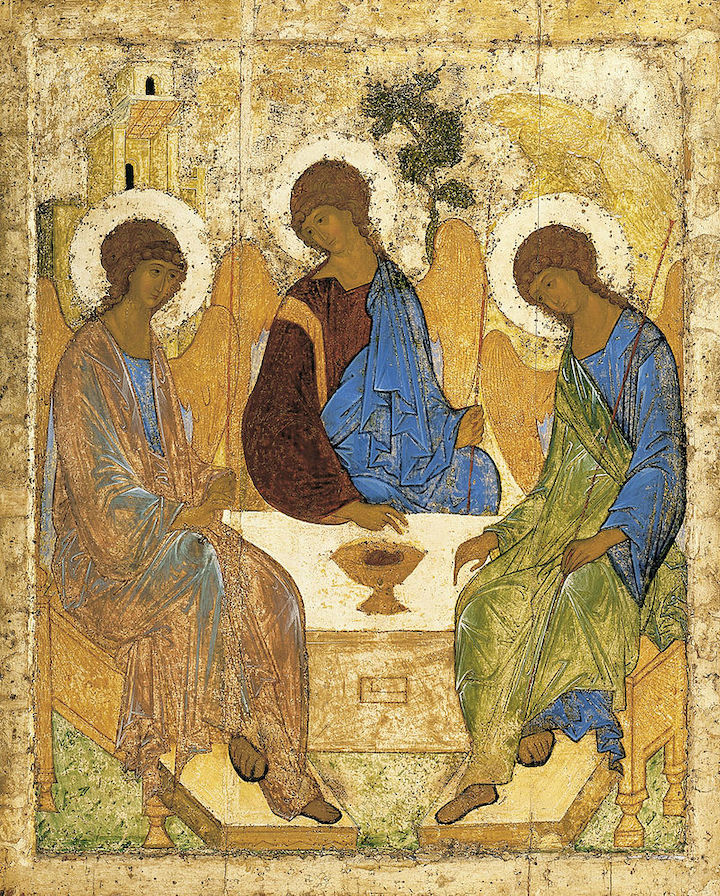Today, images consume our lives in unquantifiable ways. Well over one-billion people hold Instagram accounts, to name but one photo-sharing platform, through which they exchange billions of photos of everything from mountain peaks to the day’s breakfast. The rapacity (alas) with which posters seek out “likes” is met by blithe flicks of the thumb that barely pause a second to allow the eyes to consider any one image within the visual flood.
This deluge of images can numb us to authentic beauty in the world, be it in religious artwork copied online (such as those images often embedded in TCT columns), in our local parishes and stained-glassed windows (if we are blessed enough to frequent a church well-endowed in this regard), or even in a church building itself. These works of beauty, rather than inspire contemplation, now are blended into a blinding panorama on which Caravaggio’s The Calling of St. Matthew is indistinguishable from Aunt Sally’s Thanksgiving turkey. The sacred has been reduced to the profane, the transcendent has become one with the immanent.
As an antidote to this situation, Catholics can take a long look at Christian icons – still the dominate form of religious art for Orthodox Christians.
For a Westerner with little or no experience of such art, icons, two-dimensional figures with narrow noses and abnormal faces, can seem strange, even off-putting. Icons are nothing like Western religious art with its life-like depictions of narrative events. These we can appreciate as they are. The more imaginative among us, following the tradition of contemplative prayer, can even place ourselves in the scene with our Lord or His saints, standing alongside them or even participating in some way. But for most of us, we simply look, admire briefly, and move on.
Icons are much different. From the Greek eikōn, meaning semblance, representation, or reflection, religious icons point beyond themselves to the divine, from the immanent into the transcendent. They are a sort of visual sacrament, by which the visible transports us to the invisible God. In the words of St. Denis the Areopagite, icons are “sensible images of mysterious and heavenly visions.”

With so many centuries of history behind them, icons have developed their own theology. Joseph Ratzinger explains that the unique style of icons turns our attention from this world and “enables us to discern the face of Christ and in Him, of the Father”:
The icon is supposed to originate from an opening up of the inner senses and perceives Christ in the light of Tabor. Their whole point is to lead us beyond what can be apprehended at the merely material level, to awaken new senses in us, and to teach us a new kind of seeing, which perceives the Invisible in the visible. The sacredness of the image consists precisely in the fact that it comes from an interior vision and thus leads to such an interior vision.
Icons offer us an aesthetics of asceticism: though beautiful in their own right, icons are not meant to be a feast for the eyes. They redirect the desire of earthly sight toward visions of heaven. This is why icons can be a great blessing for us in our image-saturated culture: they are a means of visual fasting. They force us not to take a merely fleeting look, but to gaze beyond this world into the next. Hence, we cannot look at them as we look at other images: they do not let us be satisfied by what we see with our eyes, as they call us to see with the eyes of faith.
Appreciating icons is an acquired taste. It requires discipline, patience, and time – three gifts not typically associated with an “insta” culture. But by knowing the intention of this form, we can then make the effort to pray with them and through them. As we allow the visible to lead us to the invisible, we can then begin to re-appreciate the other images that surround us. We learn that appreciating beauty requires us to slow down, to halt our flying thumbs, to consider both what is before us and what it is trying to teach us.
Spending time with icons can also help kindle a religious experience from prayerfully viewing narrative paintings more typical of western Catholic art. This latter kind can also inform our prayer as we realize that the scene depicted is a hallowed moment of salvation history in which God has shown His benevolent love. From this point, the Holy Spirit can lead us in any number of directions, from contemplating Christ’s sacrifice for us, to kindling a desire to imitate the saints, to considering how God has intervened in our own lives.
In sum, western religious art tells a story that, in a tangential way, includes us as fellow members of the mystical body of Christ. The art can spring us into a deeper awareness of this reality, but only if we first take the time not just to look, but to gaze.
In an age when religious faith is becoming increasingly counter-cultural, a look across religious cultures, to an ancient tradition with much still to teach us, may be the very help we need to redeem our sight from an image-saturated culture. Icons can be a transforming means whereby we can put St. Paul’s advice into practice: “Seek the things above, where Christ is, seated at the right hand of God. Set your mind on the things above, not on the things on earth.” (Col 3:1-2)
*Image: The Trinity by Andrei Rublev, c. 1420 [Tretyakov Gallery, Moscow]. Considered my many the greatest of all icons, Rublev’s “Троица” depicts Father, Son, and Holy Spirit as Abraham’s visitors at the Oak of Mamre (Genesis 18:1–8).















